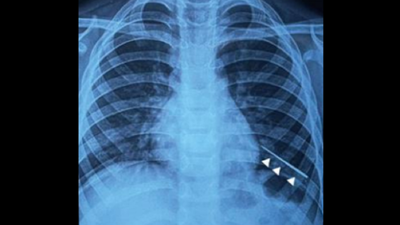- News
- City News
- delhi News
- Delhi doctors use magnet to remove needle from boy’s lung
Trending
This story is from November 5, 2023
Delhi doctors use magnet to remove needle from boy’s lung
Doctors at the All India Institute of Medical Sciences (AIIMS) in Delhi successfully extracted a sewing machine needle from a 7-year-old boy's lung using a potent magnet. The boy was admitted to the hospital in a life-threatening condition after coughing up blood. The needle was deeply lodged in his left lung, making it challenging to remove. The surgical team devised a specialized instrument with a magnet securely affixed to it, and the needle responded to the magnetic force, allowing for a safe extraction without invasive surgery.

The 7-year-old had swallowed the 4cm-long sewing machine needle
According to doctors, they used a magnet with dimensions of 4mm in width and 1.5mm in thickness in order to take out the needle.
The boy was admitted to AIIMS on November 1 in a life-threatening condition after encountering hemoptysis (cough with bleeding). Subsequent radiological investigations revealed a long sewing machine needle lodged deeply in the left lung.

Doctors said that though the paediatric surgery department at AIIMS has been doing endoscopic foreign body removal over the past few decades, there was a unique challenge presented by the needle's location within the lung and the limited space available for surgical instruments.
The surgical team, led by Dr Vishesh Jain and Dr Devendra Kumar Yadav, recognised the daunting task at hand. Dr Jain contacted someone in Chandni Chowk market who promptly facilitated the procurement of a potent magnet.
Dr Jain told TOI the primary objective was to ensure the secure delivery of the magnet to the needle's location without any risk of dislodging it into the trachea. "The team ingeniously devised a specialised instrument equipped with only one jaw, to which the magnet was securely affixed by technical officer Satya Prakash using thread and a rubber band. This ingenious instrument underwent scrupulous sterilisation in preparation for the critical procedure," he said.
With all preparations in place and the patient under anaesthesia, the team commenced with an endoscopy of the windpipe to assess the needle's location within the left lung. What they encountered was solely the needle's tip, deeply nestled within the lung. Traditional instruments would have faced insurmountable challenges in reaching this depth, said Dr Jain.
"The pivotal moment arrived as the magnet-tipped instrument was carefully inserted. It seemed almost magical as the needle responded to the magnetic force, smoothly emerging from its concealed location," he added.
"Had this not worked, we would have needed to open the chest and lungs and extract the needle with the traditional method, which would have been more difficult and invasive," Dr Jain said further.
End of Article
FOLLOW US ON SOCIAL MEDIA










